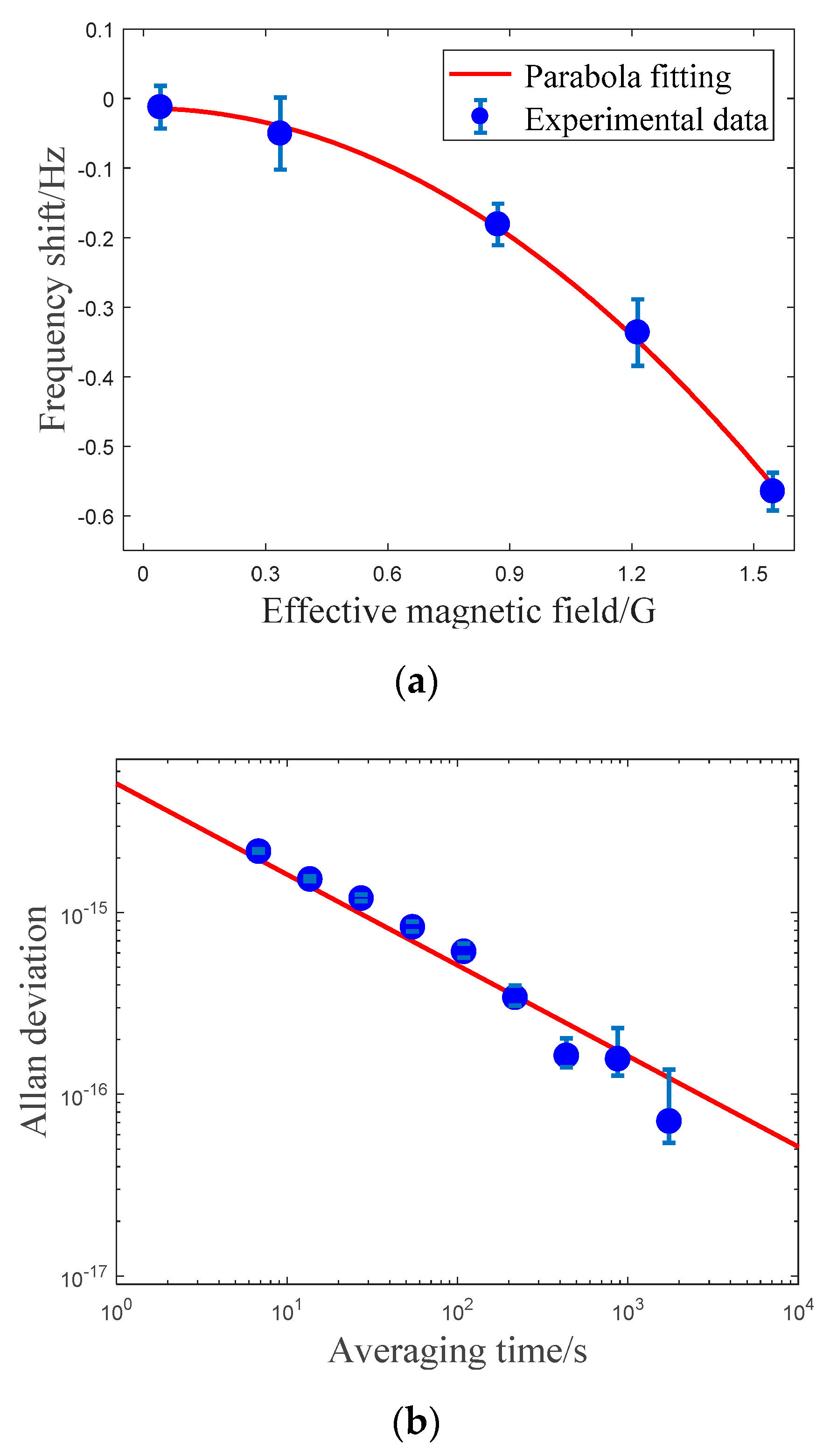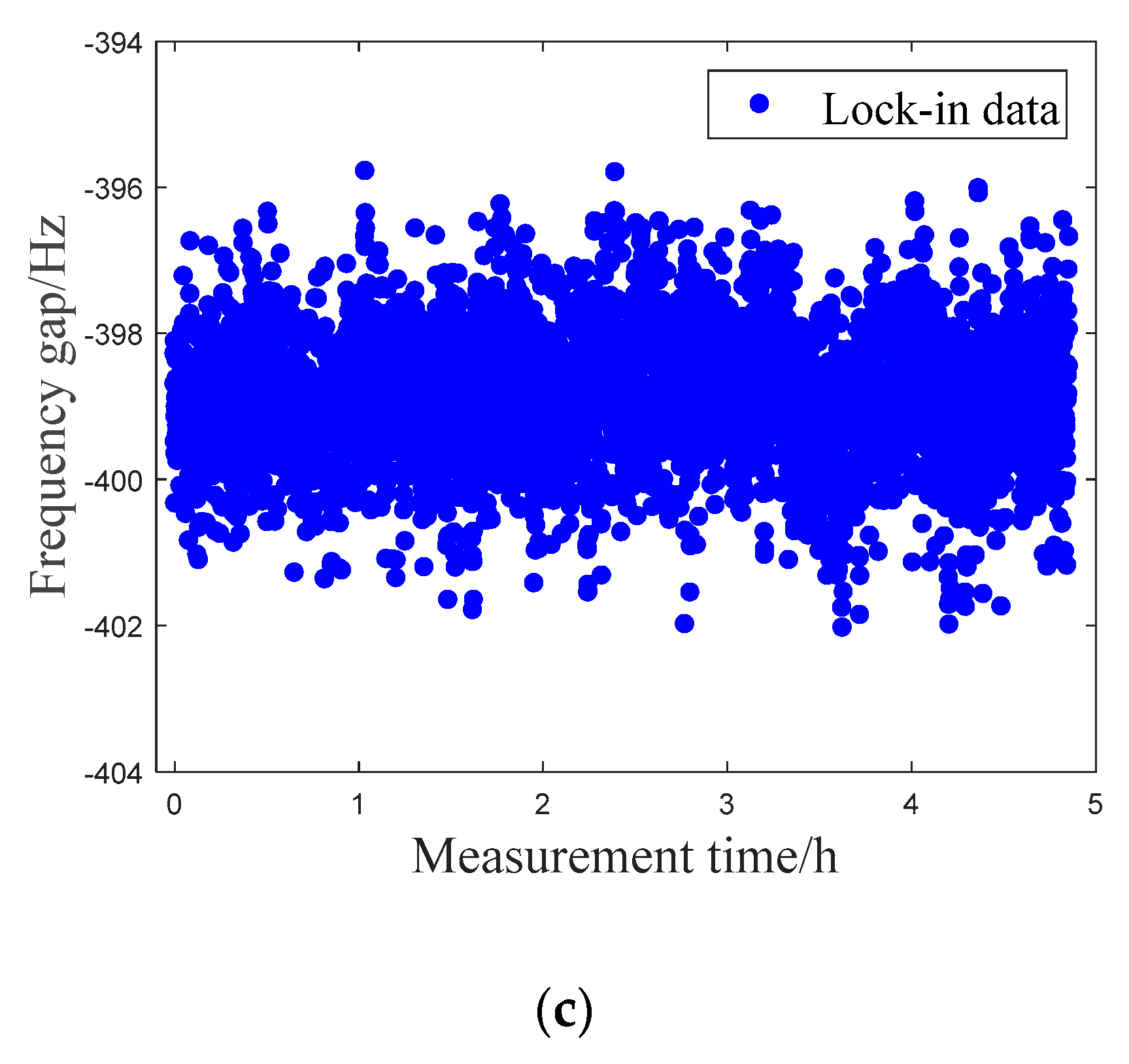An Evaluation of the Zeeman Shift of the 87Sr Optical Lattice Clock at the National Time Service Center
Abstract
:1. Introduction
2. Preparation for the 87Sr Optical Lattice Clock
2.1. Experimental Setup
2.2. The Clock Transition Spectra of 87Sr
3. The Second-Order Zeeman Coefficient Measurement and Zeeman Shift Evaluation
3.1. The Experimental Scheme for Measuring the Quadratic Zeeman Coefficient
3.2. The Experimental Results and Zeeman Shift Evaluation
4. Conclusions
Author Contributions
Funding
Acknowledgments
Conflicts of Interest
References
- Takamoto, M.; Hong, F.L.; Higashi, R.; Katori, H. An optical lattice clock. Nature 2005, 435, 321–324. [Google Scholar] [CrossRef]
- Oelker, E.; Hutson, R.B.; Kennedy, C.J.; Sonderhouse, L.; Bothwell1, T.; Goban, A.; Kedar, D.; Sanner, C.; Robinson, J.M.; Marti, G.E.; et al. Demonstration of 4.8 × 10−17 stability at 1 s for two independent optical clocks. Nat. Photon. 2019, 13, 714–719. [Google Scholar] [CrossRef] [Green Version]
- McGrew, W.F.; Zhang, X.; Fasano, R.J.; Schäffer, S.; Beloy, A.K.; Nicolodi, D.; Brown, R.C.; Hinkley, N.; Milani, G.; Schioppo, M.; et al. Atomic clock performance enabling geodesy below the centimetre level. Nature 2018, 564, 87–90. [Google Scholar] [CrossRef] [PubMed] [Green Version]
- Grebing, C.; Al-Masoudi, A.; Dörscher, S.; Häfner, S.; Gerginov, V.; Weyers, S.; Lipphardt, B.; Riehle, F.; Serr, U.; Lisdat, C. Realization of a timescale with an accurate optical lattice clock. Optica 2016, 6, 563–569. [Google Scholar] [CrossRef]
- Riehle, F. Towards a redefinition of the second based on optical atomic clocks. C.R. Phys. 2015, 16, 506–515. [Google Scholar] [CrossRef] [Green Version]
- Kolkowitz, S.; Pikovski, I.; Langellier, N.; Lukin, M.D.; Walsworth, R.L.; Ye, J. Gravitational wave detection with optical lattice atomic clocks. Phys. Rev. D 2016, 94, 124043. [Google Scholar] [CrossRef] [Green Version]
- Derevianko, A.; Pospelov, M. Hunting for topological dark matter with atomic clocks. Nat. Phys. 2014, 10, 933–936. [Google Scholar] [CrossRef] [Green Version]
- Takano, T.; Takamoto, M.; Ushijima, I.; Ohmae, N.; Akatsuka, T.; Yamaguchi, A.; Kuroishi, Y.; Munekane, H.; Miyahara, B.; Katori, H. Geopotential measurements with synchronously linked optical lattice clocks. Nat. Photon. 2016, 10, 662–666. [Google Scholar] [CrossRef]
- Delva, P.; Lodewyck, J.; Bilickiet, S.; Bookjans, E.; Vallet, G.; Targat, R.L.; Pottie, P.-E.; Guerlin, C.; Meynadier, F.; Poncin-Lafitte, C.L.; et al. Test of Special Relativity Using a Fiber Network of Optical Clocks. Phys. Rev. Lett. 2017, 118, 221102. [Google Scholar] [CrossRef] [Green Version]
- Safronova, M.S.; Kozlov, M.G.; Clark, C.W. Blackbody radiation shifts in optical atomic clocks. IEEE Trans. Ultrason. Ferroelectr. Freq. Control 2012, 59, 439–447. [Google Scholar] [CrossRef]
- Lodewyck, J.; Zawada, M.; Lorini, L.; Gurov, M.; Lemonde, P. Observation and cancellation of a perturbing dc stark shift in strontium optical lattice clocks. IEEE Trans. Ultrason. Ferroelectr. Freq. Control 2012, 59, 411–415. [Google Scholar] [CrossRef] [PubMed] [Green Version]
- Ido, T.; Katori, H. Recoil-free spectroscopy of neutral Sr atoms in the Lamb-Dicke regime. Phys. Rev. Lett. 2003, 91, 053001. [Google Scholar] [CrossRef] [PubMed] [Green Version]
- Boyd, M.M.; Zelevinsky, T.; Ludlow, A.D.; Blatt, S.; Zanon-Willette, T.; Foreman, S.M.; Ye, J. Nuclear spin effects in optical lattice clocks. Phys. Rev. A 2007, 76, 022510. [Google Scholar] [CrossRef] [Green Version]
- Lemke, N.D.; von Stecher, J.; Sherman, J.A.; Rey, A.M.; Oates, C.W.; Ludlow, A.D. p-Wave Cold Collisions in an Optical Lattice Clock. Phys. Rev. Lett. 2011, 107, 103902. [Google Scholar] [CrossRef] [PubMed] [Green Version]
- Gibble, K. Scattering of cold atom coherences by hot atoms: Frequency shifts from background gas collisions. Phys. Rev. Lett. 2013, 110, 180802. [Google Scholar] [CrossRef] [PubMed]
- Chou, C.W.; Hume, D.B.; Rosenband, T.; Wineland, D.J. Optical Clocks and Relativity. Science 2010, 329, 1630–1633. [Google Scholar] [CrossRef] [Green Version]
- Campbell, G.K.; Ludlow, A.D.; Blatt, S.; Thomsen, J.W.; Martin, M.J.; de Miranda, M.H.G.; Zelevinsky, T.; Boyd, M.M.; Ye, J.; Diddams, S.A.; et al. The absolute frequency of the 87Sr optical clock transition. Metrologia 2008, 45, 539–548. [Google Scholar] [CrossRef] [Green Version]
- Nicholson, T.L. A New Record in Atomic Clock Performance. Ph.D. Thesis, University of Colorado, Boulder, CO, USA, May 2015. [Google Scholar]
- Heavner, T.P.; Jefferts, S.R.; Donley, E.A.; Shirley, J.H.; Parker, T.E. NIS T-F1: Recent improvements and accuracy evaluations. Metrologia 2005, 42, 411–422. [Google Scholar] [CrossRef]
- Oskay, W.H.; Diddams, S.A.; Donley, E.A.; Fortier, T.M.; Heavner, T.P.; Hollberg, L.; Itano, W.M.; Jefferts, S.R.; Delaney, M.J.; Kim, K.; et al. Single-atom optical clock with high accuracy. Phys. Rev. Lett. 2006, 97, 020801. [Google Scholar] [CrossRef] [Green Version]
- Dubé, P.; Madej, A.A.; Bernard, J.E.; Marmet, L.; Boulanger, J.S.; Cundy, S. Electric Quadrupole Shift Cancellation in Single-Ion Optical Frequency Standards. Phys. Rev. Lett. 2005, 95, 033001. [Google Scholar] [CrossRef]
- Huntemann, N.; Sanner, C.; Lipphardt, B.; Schneider, T.; Tamm, C.; Peik, E. Single-Ion Atomic Clock with 3 × 10−18 Systematic Uncertainty. Phys. Rev. Lett. 2016, 116, 063001. [Google Scholar] [CrossRef] [PubMed] [Green Version]
- Ludlow, A.D.; Zelevinsky, T.; Campbell, G.K.; Blatt, S.; Boyd, M.M.; de Miranda, M.H.G.; Martin, M.J.; Thomsen, J.W.; Foreman, S.M.; Ye, J.; et al. Sr lattice clock at 1 × 10−16 fractional uncertainty by remote optical evaluation with a Ca clock. Science 2008, 319, 1805–1808. [Google Scholar] [CrossRef] [PubMed]
- Bloom, B.J.; Nicholson, T.L.; Williams, J.R.; Campbell, S.L.; Bishof, M.; Zhang, X.; Zhang, W.; Bromley, S.L.; Ye, J. An optical lattice clock with accuracy and stability at the 10−18 level. Nature 2014, 506, 71–75. [Google Scholar] [CrossRef] [PubMed] [Green Version]
- Nicholson, T.L.; Campbell, S.L.; Hutson, R.B.; Marti, G.E.; Bloom, B.J.; McNally, R.L.; Zhang, W.; Barrett, M.D.; Safronova, M.S.; Strouse, G.F.; et al. Systematic evaluation of an atomic clock at 2 × 10−18 total uncertainty. Nat. Commun. 2015, 6, 6896. [Google Scholar] [CrossRef] [PubMed]
- Westergaard, P.G.; Lodewyck, J.; Lorini, L.; Lecallier, A.; Burt, E.A.; Zawada, M.; Millo, J.; Lemonde, P. Lattice-induced frequency shifts in Sr optical lattice clocks at the 10−17 level. Phys. Rev. Lett. 2011, 106, 210801. [Google Scholar] [CrossRef] [Green Version]
- Falke, S.; Schnatz, H.; Vellore Winfred, J.S.R.; Middelmann, T.; Vogt, S.; Weyers, S.; Lipphardt, B.; Grosche, G.; Riehle, F.; Sterr, U.; et al. The 87Sr optical frequency standard at PTB. Metrologia 2011, 48, 399–407. [Google Scholar] [CrossRef] [Green Version]
- Wang, Y.B.; Yin, M.J.; Ren, J.; Xu, Q.F.; Lu, B.Q.; Han, J.X.; Guo, Y.; Chang, H. Strontium optical lattice clock at the national time service center. Chin. Phys. B 2018, 27, 023701. [Google Scholar] [CrossRef]
- Wang, Y.B.; Lu, X.T.; Lu, B.Q.; Kong, D.H.; Chang, H. Recent Advances Concerning the 87Sr Optical Lattice Clock at the National Time Service Center. Appl. Sci. 2018, 8, 2194. [Google Scholar] [CrossRef] [Green Version]
- Blatt, S.; Thomsen, J.W.; Campbell, G.K.; Ludlow, A.D.; Swallows, M.D.; Martin, M.J.; Boyd, M.M.; Ye, J. Rabi spectroscopy and excitation inhomogeneity in a one-dimensional optical lattice clock. Phys. Rev. A 2009, 80, 052703. [Google Scholar] [CrossRef]
- Hagemann, C.; Grebing, C.; Lisdat, C.; Falke, S.; Legero, T.; Sterr, U.; Riehle, F.; Martin, M.J.; Ye, J. Ultrastable laser with average fractional frequency drift rate below 5 × 10−19/s. Opt. Lett. 2014, 39, 5102. [Google Scholar] [CrossRef]
- Peik, E.; Schneider, T.; Tamm, C. Laser frequency stabilization to a single ion. J. Phys. B Atomic Mol. Opt. Phys. 2006, 39, 145–158. [Google Scholar] [CrossRef]





© 2020 by the authors. Licensee MDPI, Basel, Switzerland. This article is an open access article distributed under the terms and conditions of the Creative Commons Attribution (CC BY) license (http://creativecommons.org/licenses/by/4.0/).
Share and Cite
Lu, X.; Yin, M.; Li, T.; Wang, Y.; Chang, H. An Evaluation of the Zeeman Shift of the 87Sr Optical Lattice Clock at the National Time Service Center. Appl. Sci. 2020, 10, 1440. https://doi.org/10.3390/app10041440
Lu X, Yin M, Li T, Wang Y, Chang H. An Evaluation of the Zeeman Shift of the 87Sr Optical Lattice Clock at the National Time Service Center. Applied Sciences. 2020; 10(4):1440. https://doi.org/10.3390/app10041440
Chicago/Turabian StyleLu, Xiaotong, Mojuan Yin, Ting Li, Yebing Wang, and Hong Chang. 2020. "An Evaluation of the Zeeman Shift of the 87Sr Optical Lattice Clock at the National Time Service Center" Applied Sciences 10, no. 4: 1440. https://doi.org/10.3390/app10041440




